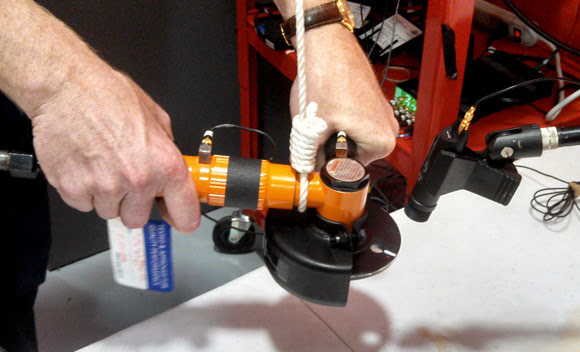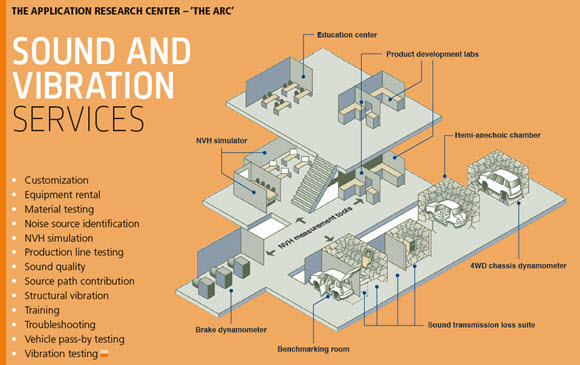Hand-arm vibration syndrome results from prolonged exposure to vibration specifically to the hands and forearms, while using vibrating tools. It starts with a ‘pins and needles’ feeling in your fingers, but can eventually lead to permanent numbness and an inability to do fine tasks, such as fastening buttons. Whole-body vibration has negative effects on general health and comfort. Alert readers will recall that the previous issue of this magazine carried two articles related to the topic of human vibration, one about a Japanese expert in the field and another about finetuning the equipment used in bowhunting. This is indicative of increasing attention to the subject of human vibration, which will also be an important focus area at Inter.noise 2014, the premier international conference on noise and vibration control, to be held this November in Melbourne, Australia.

Testing to meet vibration requirements
Andrea Frey, Project Engineer for Brüel & Kjær North America, confirms this growing interest: “We have seen more emphasis on safety in our engineering services in the past few months,” she says. “We’ve written quotes to measure the high-frequency noise emitted by automatic timers for office lighting. We have done minimum noise-level testing for electric vehicles. And in the past year, we have performed testing of vibration levels transmitted to humans during operation of different kinds of vehicles and construction equipment. We’ve also conducted tests of various hand-held tools this year to help manufacturers meet requirements for vibration transmitted to the operator’s hand during use. Most of these tests were carried out in collaboration with Sound Answers, our services partner.” All testing takes place at the ARC (Application Research Center) testing lab near Detroit, Michigan, which houses a one-of-a-kind noise and vibration solution centre with a wide array of state-of-the-art NVH testing capabilities.
“We have seen more emphasis on safety in our engineering services in the past few months.”
Andrea Frey, project engineer, Brüel & Kjær North America
The tool tests were done in accordance with the standard ISO 28927 Hand-held portable power tools – Test methods for the evaluation of vibration emission’. For these tests, a triaxial accelerometer was placed at the location where the operator grips the tool, and a tachometer was used to monitor the speed of the tool to ensure that the actual rotational speed matched the rated speed.
After this basic set-up, the ISO standard has specific sections that deal with different tools. “We operated each tool according to the ISO standard,” says Andrea. “Three different operators performed the same test so that we could understand how variation in grip affected the transmitted vibration, and each tool is tested under a variety of conditions, such as different speeds and different loads. For example, one of the tools tested was a die grinder, which requires a workpiece that you actually grind during the test. Some of the ISO sections specify a particular drill bit, or a simulated response force – it just depends on the tool. In one case we had to verify that the workpiece didn’t have any natural frequencies in the range that we were measuring.” The official results of the tests are ‘declared vibration emission values’, which can be used by manufacturers to rate the tools.
Equipment and expertise in one location
Apex Tool Group (ATG), one of the largest manufacturers of professional hand and power tools in the world, came to the ARC to run tests on a hand-held pneumatic grinder. According to John Stewart, Chief Engineer, Components, Technology and Intellectual Property for Apex, time and confidence were two of the main reasons for using the ARC’s facilities and expertise. “We simply didn’t have the time or manpower to run the tests ourselves,” he says, “and it certainly would have taken us longer to complete the tests. Also, using the ARC ensured that it would be done right. Their engineers are very knowledgeable, and I was confident our product would be in compliance with the necessary international standard. The bottom line is that the ARC enabled us to finish our programme efficiently.”
"Using the arc ensured that we were doing it right. I was confident our product would be in compliance."
John Stewart, Chief Engineer, Apex Tool Group
“I see several advantages to customers using the ARC for this type of testing,” says Andrea. “First, Brüel & Kjær actually makes the testing equipment, which means not only that it is accurate and reliable, but also that we have all the equipment we need right here and ready to go. Second, the ARC offers dedicated facilities. Something small like a hand tool could in theory be tested in an office, but it’s very noisy and messy and disruptive to other employees. For something larger that needs to be affixed to a bedplate, or driven on a dynamometer, or tested for noise at the same time as the vibration test, we can accommodate all those kinds of tests, too. Third, we have all the people right here. Brüel & Kjær has four application engineers at the ARC, and our services partner, Sound Answers, is right down the hall with 11 more engineers. That’s a lot of knowledge and experience all in one location, and it means that we can support just about any noise- or vibration-related request that might come up during testing.”

Suscríbase a nuestro boletín informativo y recibirá las últimas noticias de B&K sobre sonido y vibración


